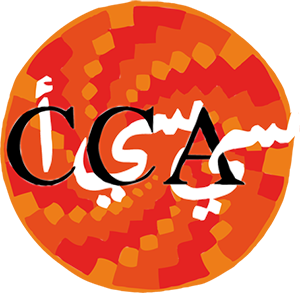In previous weeks we’ve been blogging about the Mosaic Conservation Course General Meeting, an exciting event that gathered MCC alumni in Sardinia for a full day workshop. Read an overview of the Meeting here, and a report on Syrian alumni’s presentations in Session 1 here.
Now for the Meeting’s second session, which featured presentations from four ex-participants of the MCC Jordan and Tunisia 2012-2013 course.
After returning from the course Nihad Hendawi chose to focus her work at the Jordan Museum on restoring mosaics that had been laid on cement within a metal frame. In the case presented she removed old backing materials from the mosaic before reapplying it on a new support using mortar. Together with the museum team she experimented an alternative support to Aerolam. Thanks to the much lower cost of this material the project was considered sustainable and its funding was approved by the department. The new support was built applying a fiber-glass panel to an aluminum framework. This method was not entirely satisfactory as the panel became partially detached from the framework some time after treatment, causing two small rises in the tessellatum. The overall cost however was extremely low and the mosaic is now on display in the Museum.
Ziyad Othman described a recent project as a case study to present a method for lifting mosaic floors from their original site. After accurate, “tessera by tessera” documentation and surface cleaning, the lifted sections were faced and numbered. The rear was cleared of old mortar manually and using electrical tools. The fragments were then applied on movable supports.
Jamel Lazid discussed the detachment of mosaics from the church of Diacre Victor, a late Byzantine site in the north west of Tunis. The lifting operations, necessary because a road had to be built across the site, were carried out in difficult weather conditions, which required the use of heaters to dry the facing material. Detachment operations were preceded by detailed documentation carried out on paper and nylon sheets first and subsequently transferred on electronic records.
His colleague Anis Ouslati compared two cases in which mosaic decorated baptismal fonts were lifted. A baptismal font that was detached in pieces in the 1970s, now displayed in the Sousse Museum, presented many issues during re-assemblage, with the result that the reconstructed structure is deformed. To avoid similar problems, when confronted with the task of lifting a baptismal font from the church of Diacre Victor the team from Sousse decided to extract it as a whole piece after facing the surface.
In the following discussion Roberto Nardi noted that the presentations by Anis and Jamel clearly highlight how still today there is a great need to discuss the issue of appropriate planning for construction work. Ultimately, mosaics pay a high price for what is first and foremost a political problem.
